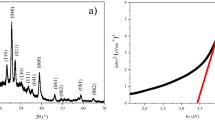Abstract
Diode ideality factors of 2.0–8.0 have been reported in GaN-based p-n junctions. These values are much higher than the expected values of 1.0–2.0 as per the Sah-Noyce-Shockley theory. We propose a fundamentally new model for the high ideality factors obtained in GaN-based diodes. This model is based on the effect of moderately doped unipolar heterojunctions as well as metal–semiconductor junctions in series with the p-n junction. A relation for the effective ideality factor of a system of junctions is developed. A detailed experimental study is performed on diodes fabricated from two different structures, a bulk GaN p-n junction structure and a p-n junction structure incorporating a p-type AlGaN/GaN superlattice. Bulk GaN p-n junction diode displays an ideality factor of 6.9, whereas the one with the superlattice structure displays an ideality factor of 4.0. In addition, device simulation results further strengthen the model by showing that moderately doped unipolar heterojunctions are rectifying and increase the effective ideality factor of a p-n junction structure.
Similar content being viewed by others
References
C. Sah, R. N. Noyce and W. Shockley, Proc. IRE 45, 1228 (1957).
V. A. Dmitriev, MRS Internet J. Nitride Semicond. Res. 1, 29 (1996).
H. C. Casey Jr, J. Krishnankutty S. Muth, and J. M. Zavada, Appl. Phys. Lett. 68, 2867 (1996).
P. Perlin, M. Osinski, P. G. Eliseev, V. A. Smagley, J. Mu, M. Banas, and P. Sartori, Appl. Phys. Lett. 69, 1680 (1996).
F. Capasso and G. Margaritondo, “Heterojunction band discontinuities: physics and device applications” (North-Holland, Netherlands, 1987).
A. Chandra and L. F. Eastman, Electron. Lett. 15, 90 (1979).
S. R. Forrest and O. K. Kim, J. Appl. Phys. 52, 5838 (1981).
E. L. Waldron, Y.-L. Li, E. F. Schubert, J. W. Graff, and J. K. Sheu, Appl. Phys. Lett. 83, 4975 (2003).
E. H. Rhoderick and R. H. Williams, “Metal–Semiconductor Contacts”, Second Edition, (Oxford University Press, Oxford, 1988) pp. 129.
Y.-L. Li, E. F. Schubert, J. W. Graff, A. Osinsky, W. F. Schaff, Appl. Phys. Lett. 76, 2728 (2000).
T. Gessmann, Y.-L. Li, E. L. Waldron, J. W. Graff, E. F. Schubert, and J. K. Sheu, Appl. Phys. Lett. 80, 986 (2002).
Acknowledgments
This work was supported in part by DARPA/ARO (Dr. J. Carrano), the NSF (Dr. U. Varshney), and the ONR/Univ. New Mexico (Drs. Wood and Hersee).
Author information
Authors and Affiliations
Rights and permissions
About this article
Cite this article
Shah, J.M., Li, Y., Gessmann, T. et al. Experimental Analysis and a New Theoretical Model for Anomalously High Ideality Factors (n ≫ 2.0) in GaN-based p-n Junction Diodes. MRS Online Proceedings Library 798, 689–694 (2003). https://doi.org/10.1557/PROC-798-Y7.11
Published:
Issue Date:
DOI: https://doi.org/10.1557/PROC-798-Y7.11




